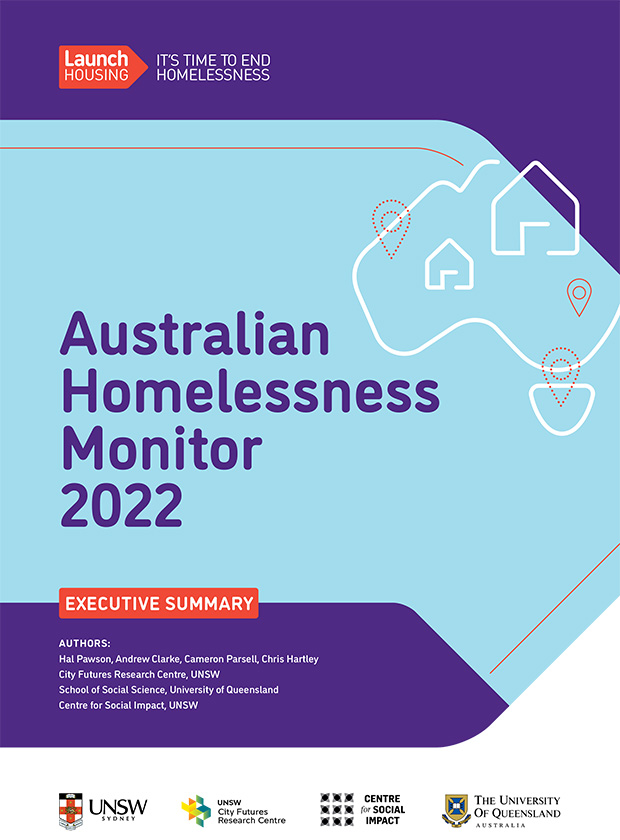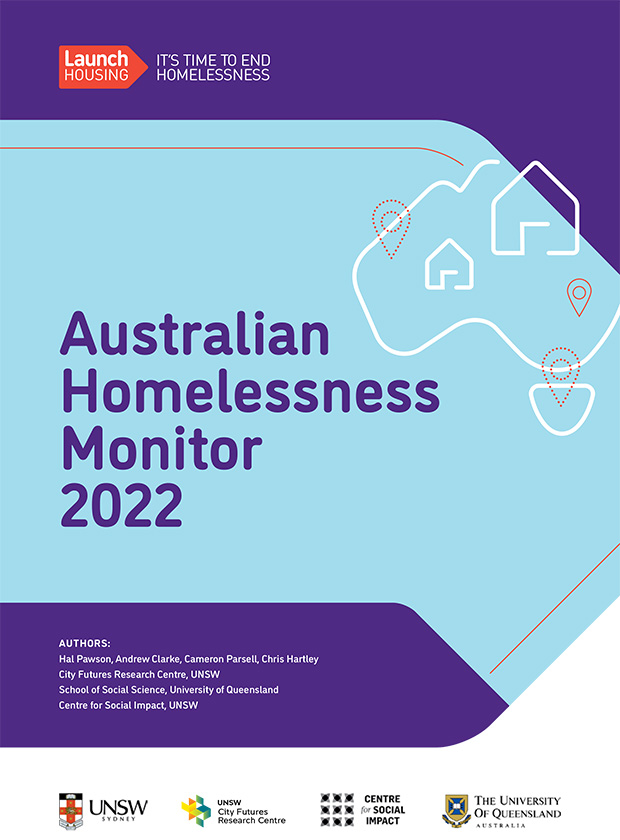Australian Homelessness Monitor 2022
The latest Australian Homelessness Monitor shows that rising homelessness continues to outstrip Australia’s growing population.
The 2022 Australian Homelessness Monitor takes a deep dive into the COVID crisis years, conducting an investigation of how housing markets are changing in Australia and what that means for people who are experiencing homelessness.
It also looks at how economic factors are creating a higher risk for those living below the poverty line. While the COVID-19 pandemic prompted us to take action to help those rough sleeping, other pre-existing trends continued, with some getting worse.
This is the third report commissioned by Launch Housing, conducted by the University of New South Wales (City Futures Research Centre and the Centre for Social Impact) and the University of Queensland.

Key findings
- Across Australia, the average monthly number of specialist homelessness service (SHS) users grew from 84,800 people in 2017-18 to 91,300 people in 2021-22. This represents a rise of 8%, which is double the current growth rate of new households forming each year.
- The number of people experiencing homelessness has changed drastically across different parts of Australia. While South Australian numbers have remained about the same for 4 years now, there has been a 24% increase in homeless people in Tasmania and a 22% increase in homeless people in Queensland.
- Nationally, since 2017-18 homelessness (SHS service users) has grown at double the rate in regional Australia as in capital cities (13% compared with 6%); numbers have increased fastest in regional Queensland (up 29%) and in regional Western Australia (up 35%).
- Australia-wide, housing affordability has been one of the fastest growing causes for homelessness to date; from 4 years ago up until 2021-22, the average monthly number of SHS service users who experience this issue in triggering their need for help has risen by 27%.
- First Nations Australians and those with mental illness are the two fastest growing groups of people using these services, jumping by 23% and 20%. By 2021-22, Indigenous persons (including First Nations) made up 27% of all users – which was a seven fold increase from when they represented only about 1.5% of Australian society.
- Recent rental housing market trends have likely contributed to ongoing homelessness growth, and to the risk that this will continue into 2023:
- The period 2020-22 saw a dramatic spike in private market rent inflation across Australia, with renting prices (asking rents) rising at rates unseen since 2008; latest figures (June 2022) show annual private rent inflation running at 1.5 times the rate of general consumer price rises – 9.5% compared with 6.1%.
- At 2.6%, the marginal expansion of Australia’s social housing stock for the period 2016-2021 markedly lagged both population (5.7%) and household growth (8.2%). Consequently, the proportionate share of social housing has continued to drift downwards.
- Service provision innovations triggered by the pandemic have included:
- Structured housing and support programs in New South Wales and Victoria to assist the most disadvantaged residents of COVID-19 emergency accommodation (EA) in accessing long-term housing; and
- The de-concentration of emergency housing and enhanced regulation of boarding houses in Queensland, the latter legitimizing them as a private housing option for former COVID-19 EA service users.
- In the next decade, there should be an estimated net gain of around 9,000 social rental dwellings due to agreements made between state and federal governments.
- To avoid the decline of social housing representation from 2025, new government investments are necessary.
- LGAs play an integral role in reducing and solving homelessness. LGAs’ roles need to be clarified and incorporated into both state and national policies on homelessness.



